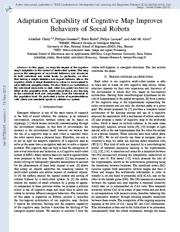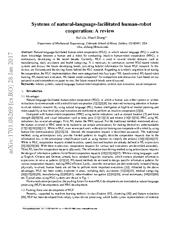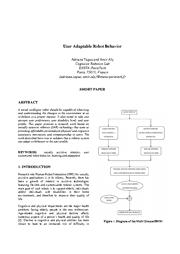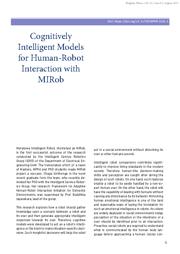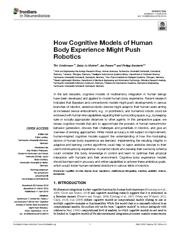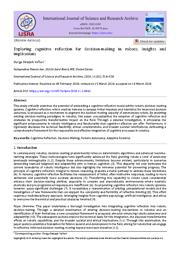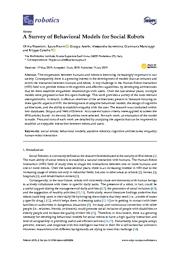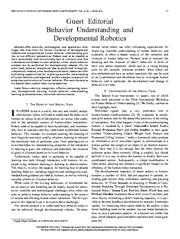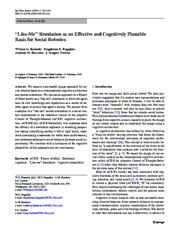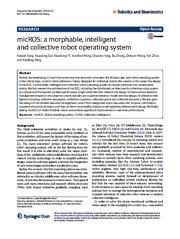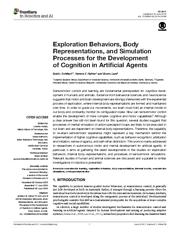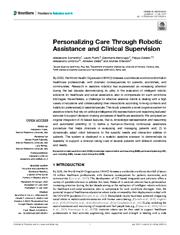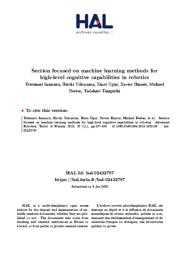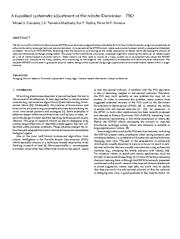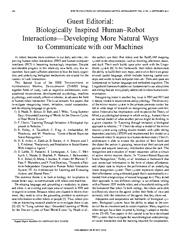A copy of this work was available on the public web and has been preserved in the Wayback Machine. The capture dates from 2014; you can also visit the original URL.
The file type is application/pdf.
Filters
Adaptation capability of cognitive map improves behaviors of social robots
2012
2012 IEEE International Conference on Development and Learning and Epigenetic Robotics (ICDL)
This map governs the emergence of non-trivial behaviors and structures at both individual and social levels. ...
In this paper, we study the impact of the cognitive map's adaptation in the context of multi-robot system. ...
ACKNOWLEDGMENT The authors would like to thank the financial support of the Tunisian General Direction of Scientific Research and Technological Renovation (DGRSRT), under the ARUB program 01/UR/11 02, ...
doi:10.1109/devlrn.2012.6400832
dblp:conf/icdl-epirob/ChattyGKLA12
fatcat:x2aetyutkjbn7h443bwcgomsze
Systems of natural-language-facilitated human-robot cooperation: A review
[article]
2017
arXiv
pre-print
social companion for comparison and discussion. ...
Regarding to a robot s cognition level during the cooperation, the NLC implementations then were categorized into four types NL-based control, NL-based robot training, NL-based task execution, NL-based ...
However, robots' reasoning capability was not largely improved since demonstration-based training was actually a sensor-data-level imitation of human behaviors and ignored the "unobservable human behaviors ...
arXiv:1701.08269v2
fatcat:54fstpat7rh5pbbrwbxsgwuzv4
User adaptable robot behavior
2011
2011 International Conference on Collaboration Technologies and Systems (CTS)
A social intelligent robot should be capable of observing and understanding the changes in the environment so as to behave in a proper manner. ...
The work described here tries to validate that a robotic system can adapt its behavior to the user profile. ...
CUSTOMIZED ROBOT BEHAVIOR Creating robotic systems capable of adapting their behavior to user personality, user preferences, user profile, and user disability level (physical/cognitive) in order to provide ...
doi:10.1109/cts.2011.5928681
dblp:conf/cts/TapusA11
fatcat:qsnjrogngnht7cwzzk2xm4dow4
Cognitively Intelligent Models for Human-Robot Interaction with MIRob
2021
Bolgoda Plains
Such insightful decisions will help the robot act in a social environment without disturbing its user or other humans around. ...
Therefore, cognitive models were developed to act as a robot's intelligence or the brain to make situation-specific decisions. ...
Later MIRob has been improved with more sensors such as LIDAR sensors and advanced depth sensors to improve its cognitive capabilities and the perception of its surrounding. ...
doi:10.31705/bprm.2021.4
fatcat:lsoydb5y55bnfofcokmb3rmeba
How Cognitive Models of Human Body Experience Might Push Robotics
2019
Frontiers in Neurorobotics
Cognitive body experience models should be improved in accuracy and online capabilities to achieve these ambitious goals, which would foster human-centered directions in various fields of robotics. ...
In this perspective paper, we review cognitive models that aim to approximate the process of human sensorimotor behavior generation, discuss their challenges and potentials in robotics, and give an overview ...
Developmental robotics research draws its appeal at the edges of engineering, developmental psychology, and cognitive science by potentially improving the capabilities and autonomy of robots. ...
doi:10.3389/fnbot.2019.00014
pmid:31031614
pmcid:PMC6470381
fatcat:gc64p4mctjehhi3p7d47breyxm
Exploring cognitive reflection for decision-making in robots: Insights and implications
2024
International Journal of Science and Research Archive
Cognitive reflection, which enables humans to surpass initial impulses and heuristics for improved decision outcomes, is proposed as a mechanism to augment the decision-making capacity of autonomous robots ...
This study critically examines the potential of embedding a cognitive reflection model within robotic decision-making systems. ...
adaptability and sophisticated behavior. ...
doi:10.30574/ijsra.2024.11.2.0463
fatcat:beobvx4z5fbdlgiz5q45arwxbi
A Survey of Behavioral Models for Social Robots
2019
Robotics
In details, it offers an overview of the architectures present in literature focusing on three specific aspects of HRI: the development of adaptive behavioral models, the design of cognitive architectures ...
A key challenge in the Human-Robot Interaction (HRI) field is to provide robots with cognitive and affective capabilities, by developing architectures that let them establish empathetic relationships with ...
Conflicts of Interest: The authors declare no conflict of interest. ...
doi:10.3390/robotics8030054
fatcat:2tugryoiqzcehgg6ffm3r7jzva
Guest Editorial Behavior Understanding and Developmental Robotics
2014
IEEE Transactions on Autonomous Mental Development
On the other hand, behavior analysis can also be performed through developmental robotics, since developmental social robots can offer stimulating opportunities for improving scientific understanding of ...
Robots need to be capable to learn dynamically and incrementally how to interpret, and thus understand multimodal human behavior, which means behavior analysis can be performed for developmental robotics ...
Taken together, these contributions exemplify schemes inspired by human development and behavior to improve robot behavior, as well as provide robotic systems on which cognitive theories and their predictions ...
doi:10.1109/tamd.2014.2328731
fatcat:2hbfhaxug5dapb3hva7bf2t7iy
"Like-Me" Simulation as an Effective and Cognitively Plausible Basis for Social Robotics
2009
International Journal of Social Robotics
social behavior (primate social experiments). ...
We present a successful design approach for social robotics based on a computational cognitive architecture and mental simulation. ...
Our work benefited from discussions with Dan Bothell and the vision work of Ben Fransen and robotics of William Adams and Alan Schultz. ...
doi:10.1007/s12369-009-0014-6
fatcat:rgsgyscb6nh3xh7nisq6uucdhu
micROS: a morphable, intelligent and collective robot operating system
2016
Robotics and Biomimetics
We also give the design of morphable resource management, which first categorizes robot resources into physical, information, cognitive and social domains, and then achieve morphability based on self-adaptive ...
We then present the design of autonomous behavior management based on the observe-orient-decide-act cognitive behavior model and the design of collective intelligence including collective perception, collective ...
Autonomous behavior and collective intelligence Collective behavior of robots The OODA loop is a famous cognitive behavioral model proposed by John Boyd [15] . ...
doi:10.1186/s40638-016-0054-y
pmid:27942434
pmcid:PMC5124045
fatcat:adsh6md3ojfedcr3le47lp7v7u
Exploration Behaviors, Body Representations, and Simulation Processes for the Development of Cognition in Artificial Agents
2016
Frontiers in Robotics and AI
Therefore, the capability to re-enact sensorimotor experience might represent a key mechanism behind the implementation of higher cognitive capabilities, such as behavior recognition, arbitration and imitation ...
How can sensorimotor control enable the development of more complex cognitive and motor capabilities? ...
Equipping robots with multimodal body representations, capable of adapting to dynamic circumstances, would indeed improve their level of autonomy and interactivity. ...
doi:10.3389/frobt.2016.00039
fatcat:fd4dirm75feprjg3penleqrv5a
Personalizing Care Through Robotic Assistance and Clinical Supervision
2022
Frontiers in Robotics and AI
clinicians in evaluating and managing patients and; 2) to dynamically adapt robot behaviors to the specific needs and interaction abilities of patients. ...
Research in assistive robotics has experienced an increasing attention during the last decade demonstrating its utility in the realization of intelligent robotic solutions for healthcare and social assistance ...
Their results suggested that the usage of a robot in this context improved socialization among the participants. ...
doi:10.3389/frobt.2022.883814
pmid:35903720
pmcid:PMC9315221
doaj:9739b63c95f74367aa853c3830da9f1b
fatcat:zwpyy4zasnemrnzosb2vygd2dq
Section focused on machine learning methods for high-level cognitive capabilities in robotics
2019
Advanced Robotics
robotics researchers with a special emphasis on adaptive high-level cognition. ...
Low-level cognitive capabilities include physical control, behavioral motion generation, and sensory perception (node (i) in Figure 1 ). ...
doi:10.1080/01691864.2019.1625183
fatcat:oio3575z5fadhezvzpfsemqrbe
A fuzzified systematic adjustment of the robotic Darwinian PSO
2012
Robotics and Autonomous Systems
This paper further extends the previously proposed algorithm adapting the behavior of robots based on a set of context-based evaluation metrics. ...
The adapted RDPSO is evaluated in groups of physical robots, being further explored using larger populations of simulated mobile robots within a larger scenario. ...
A balance between cognitive and social weights needs to be established and adapted throughout the mission depending on contextual mission-related knowledge of the cognitive or social levels of robots, ...
doi:10.1016/j.robot.2012.09.021
fatcat:t5mc6am23vbuxnv6vodu7zlpf4
Guest Editorial: Biologically Inspired Human–Robot Interactions—Developing More Natural Ways to Communicate with our Machines
2012
IEEE Transactions on Autonomous Mental Development
, machine psychology, and socially affective robotics, to advance the field of human-robot interaction. ...
As robots become more common in our daily activities, improving human-robot interactions (HRI) and human-computer interfaces (HCI) is becoming increasingly important. ...
A model of dopaminergic and serotonergic neuromodulation drove their robot's behavior and allowed the robot to adapt to its opponents' strategies. ...
doi:10.1109/tamd.2012.2216703
fatcat:tmaczjjdmzcivewuuq4asrisqu
« Previous
Showing results 1 — 15 out of 12,975 results

